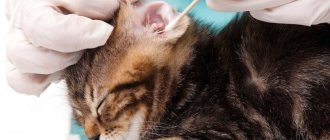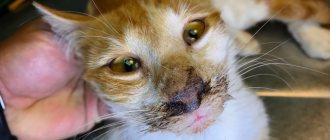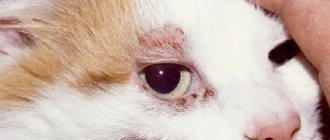Since your cat is part of your family, you should always take care of it. Pet owners know it's important to keep an eye on their fur babies, so when you notice white worms in your cat's stool, you have a right to be concerned.
Fortunately, the solution to this problem is very simple, not to mention inexpensive, so your beloved cat can feel better and improve its health in no time. If you think about it, this is what all pet parents want for their furry family members.
What types of white worms are there in cats?
In general, this appearance is characteristic of two main types of parasitic worms:
- Ascaris (i.e. “harmful” nematodes).
- Flatworms (cestodes, which include all kinds of tapeworms and tapeworms).
Of course, experienced breeders know about the existence of parasitic flukes (they are also liver flukes), but the problem is that it is impossible to see them in a sick animal. To do this, it is necessary to open his liver. True, there are cases when opisthorchis or fascioli (young and simply small individuals), having “rolled” down the bile ducts, end up in the feces.
But even in this case, it is problematic to see them, and you cannot call them “white” (the body of such worms has a dark color). Thus, only two types of helminths should be considered.
White long worms: parasitic nematodes and their characteristics
In most cases of helminths appearing in animal feces, we are talking about parasitic species of nematodes. Perhaps they are the most typical and widespread white long worms.
In cats, two types are most often found:
- Toxocara cati.
- Toxacaris leonine.
The disease caused by them is called toxocariasis. In kittens, a similar disease is called toxoascariasis. Despite the huge diversity of species, all roundworms are similar in the characteristics of their life cycle, nutrition, and other features of their life.
Routes of infection
We should start by describing the routes of infection. Veterinarians believe that nematodes are characterized by four (!) methods of infection:
- Standard, nutritional. In this case, the pet “catches” worms by eating food contaminated with parasite eggs, or by drinking equally contaminated water. In addition, this also includes cases of infection when eating intermediate hosts, which can be small mouse-like rodents, birds or even insects. It is not at all necessary that eggs or larvae of parasitic worms are present in their body: all this can be on their skin, paws, etc. It is for this reason that cats that at least periodically walk outside are many times more likely to get sick. However, parasite eggs can just as easily be brought by their owners on street shoes.
- Infection... through the skin. In some species of round parasitic worms, the larvae initially lead an “honest” lifestyle, living in the upper layers of the soil. And when a cat walks on the ground, its delicate paw pads, whose skin is so thin, are in a very vulnerable state. The larvae gnaw through the skin, and then get to the nearest vessel, through which they enter the general bloodstream of the animal.
- Infection through mother's milk.
- Intrauterine infection. A variant characteristic specifically of parasitic nematodes (although in the case of some cestodes it also occurs). With a high intensity of invasion, the larvae can easily overcome the placental barrier, penetrating directly into the body of unborn kittens.
And it's very bad. The problem is that the invading larvae carry a lot of pathogenic microflora, and they also have problems with selectivity of penetration. It is unknown where exactly the little parasite will gnaw its way through, and it is also unknown what complications the kitten will experience as a result.
There is a possibility that as a result of such infection, the animal will subsequently develop many congenital pathologies. In addition, in such cases, the probability of death of the entire offspring increases sharply, which is always fraught with severe gynecological pathologies in the mother. Thus, a cat may well remain infertile as a result of “ordinary” helminthic infestations.
Life cycle of roundworm
Parasitic roundworms are interesting creatures. Their development cycle has long been of particular interest to researchers.
There are certain nuances, but in most species it proceeds as follows:
- First, the eggs or larvae of the worm enter the animal’s body. In the latter case, as a rule, infection occurs with the direct participation of an intermediate host, in whose body the young parasites mature to a certain stage of development.
- In the lumen of the gastrointestinal tract, digestive enzymes act on the shell of the egg or capsule in which the larva “hides”, after which the parasite comes out.
- Although this seems illogical, the larva does not remain in the digestive tract, but immediately gnaws through the intestinal walls, heading towards the nearest blood vessels. Having broken through the wall of the latter, the parasite enters the general bloodstream.
- Using the bloodstream as if it were a road, the larva travels to the lungs. And this is where the problems begin. Firstly, the parasite on its body and inside it carries a huge amount of pathogenic and conditionally pathogenic microflora, which, once in the delicate lung tissue, inevitably causes the appearance of an inflammatory focus. Secondly, the larva does not have an internal “compass”, and therefore it is far from certain that it will be able to get into the lungs. In particular, this is how some of the parasites are deposited in the tissues of the mammary glands. The problem is that the larva could just as easily end up in any organ, including the heart or liver.
- The larva remains in the lungs for approximately two or three weeks. During this time, it eats well, using the tissue of the pulmonary alveoli to nourish it, growing to the required stages. The need for a “pulmonary vacation” is due to the fact that at first the larvae of these parasites need oxygen, which is not available in the intestines.
- When the time comes, the body of the small parasite begins to secrete caustic and irritating substances. They cause the animal to develop a strong cough, due to which the larvae are coughed up along with sputum. Together with it, they are swallowed and enter the gastrointestinal tract a second time.
The parasite is not sent back to the lungs, remaining in the intestines for the rest of its life.
Symptoms of white worm infection
As in cases of other helminthiasis, infection with parasitic nematodes often occurs without the development of pronounced clinical symptoms.
But still, many pathologies are accompanied by constant signs (sometimes quite vague):
- Bloating. This is especially pronounced in the case of kittens.
- Exhaustion of the animal. This is true for cases of severe helminthic infestations. Animals in such situations literally have their ribs sticking out, which sharply contrasts with the bloated abdomen, which creates a deceptive impression of “fatness.”
- Digestive problems are common , resulting in intermittent cases of diarrhea and severe constipation.
- It is also possible to have a perversion of appetite when the animal eats inedible objects, as well as chalk, clay or lime. This is largely due to a lack of vitamins and microelements, which are actively consumed by the parasite’s body.
The effect of helminths on the animal
Worms are harmful to a cat's health. They deprive their prey of nutrients and vitamins. This leads to decreased immunity and anemia. The animal gradually weakens and becomes vulnerable to various infectious diseases.
Mechanical
Worms damage internal organs and tissues with their suckers. This often leads to the development of an inflammatory process and even necrosis. When there is a large accumulation of worms in the intestine, the walls become stretched and the lumen becomes blocked. Some animals die due to ruptures of internal organs.
Biochemical
Toxic substances that worms secrete poison the body. First, intoxication leads to allergic reactions. If no measures are taken, the cat will develop chronic dermatitis. Due to the constant presence of toxins in the body, the functioning of the liver and kidneys will be impaired.
White flatworms: parasitic cestodes
In cats, white flatworms are less common, but it does happen. Cestodes (that is, flat parasitic worms) in some respects are seriously different from their “round” colleagues, both in body structure and physiological characteristics:
- The body of flatworms consists of many segments , each of which is a real container tightly packed with ripening eggs. Closer to the end of the body (and in cestodes it can reach several meters) there are segments with already matured eggs. Every day, thousands and hundreds of thousands of potential parasites are released into the external environment in the feces of a sick cat.
- The worm grows from the head. Thus, if due to some unfavorable (for the worm) factors it loses its entire body, the head, if it remains intact, will quickly grow a new one. And this is a big problem in treatment. If to remove roundworms it is enough to use drugs that simply stun the worms and promote their natural removal from the body, then with cestodiasis it is necessary to use “serious”, poisonous drugs that kill the worm “outright”. True, the body of the animal itself also has a hard time.
- Unlike roundworms, flatworms switched to a parasitic lifestyle a very long time ago, and therefore their body, in fact, is a combination of two systems: the reproductive (most species are bisexual) and the “digestive.” The name of the latter is in quotation marks because the body of these parasites only absorbs nutrients over the entire surface.
- An unpleasant feature of cestodes is the way they are secured in the intestines. As a rule, parasites use peculiar hooks for this purpose, and in more rare cases, suction cups. The problem is that the strength of this attachment is so good that sometimes the remains of the worm are removed surgically!
Routes of infection
As for the routes of infection, in the case of cestodes there is only one – nutritional. Parasites enter the cat's body through food or water. The clinical picture with cestodiasis is approximately the same as in the case of infection with roundworms; there are no striking features.
Note that the body of parasitic worms secretes much more toxins than if compared with roundworms, and therefore with parasitic cestodias the likelihood of severe intoxication is much higher.
It leads to a severe deterioration in the condition of the skin and coat; in these situations, the exhaustion of the animal is more pronounced.
Development cycle
In cestodes it is much simpler. The larvae of these worms do not mature in the lungs. It is enough for them (in the form of an egg or in the body of an intermediate host) to enter the cat’s digestive system, after which their rapid growth begins. As a rule, about a month passes from the moment a larva enters a cat’s gastrointestinal tract until the first eggs appear in its feces, but much depends on the condition of the animal, the time of year, and other factors.
Side effects of deworming
Improperly performed deworming can harm the kitten.
Unsuitable anthelmintics can cause side effects in your kitten:
- nausea, vomiting;
- foam at mouth;
- allergic reactions;
- dyspnea;
- problems with breathing and stool;
- sudden weight loss.
The most common adverse reaction is diarrhea. If it lasts no more than 38 hours, this is normal. This is how the pet’s body reacts to the active substances and accelerates the elimination of dead parasites. When side effects appear (nausea, vomiting, itching, muscle spasms, salivation), this indicates intolerance to the components of the composition. Then you need to change the anthelmintic.
In addition to side effects, improper deworming can lead to serious complications - anaphylactic shock, bleeding, sudden changes in pressure, breathing problems, and kidney function.
Prevention of helminthiasis in cats
In general, prevention is quite simple, but it is far from a guarantee of the “purity” of the cat:
- Firstly, it is necessary to monitor the quality of food given to the cat. All “natural” products should be purchased only in trusted places. Remember that the eggs of many parasites can withstand quite long heat treatment without problems. It is generally undesirable to use river fish to feed cats!
- Secondly, deratization should be carried out regularly in private homes.
- Thirdly, the house should be regularly wet cleaned, thoroughly washing the most remote corners. This way you will be able to get rid of fleas, which are mechanical carriers of many diseases.
- Fourthly, at least once a quarter you need to take cat feces for analysis. In problem regions, preventive treatment of cats with anthelmintic drugs is recommended at the same time.
- Fifthly, if the area where the breeder lives is unfavorable for some helminthiases, the animal’s street walks should be minimized. An exception can be made only for the cold season, when the risk of infection is significantly reduced.
Content
- The causative agent of parasitic infection is pinworm
- Causes of pinworm infection
- What complications does the disease cause?
- Symptoms of the disease Acute period
- Chronic stage
Enterobiasis is an infection of the body with helminths - pinworms. Young children are at risk, but children of other ages can also be infected.
Are white worms dangerous for humans?
It all depends on the specific type of parasite. Thus, most cat roundworms are not dangerous to humans. A certain risk of infection exists only in the case of young children and the elderly, but even in their bodies the worms do not live for a long time; the immune system can handle them quite well. But with cestodes everything is not so simple.
The problem is that for some parasitic flatworms, humans can be not only the definitive host, but also an intermediate host, and this is very, very dangerous.
The danger lies in the larvae of parasites, which, having entered the body of the “lucky one,” are encapsulated in the muscles, climb into the internal organs, and even cases of the formation of parasitic cysts directly in the brain have been described.
Important! Alveococci and echinococci are deadly to humans!
So what should an owner do if he sees clumps of worms coming out of a cat in feces or vomit? First, you need to call your veterinarian right away. Secondly, when caring for a sick animal, you must strictly follow several simple rules:
- After any contact with the cat, you must wash your hands thoroughly.
- It is advisable to isolate the pet in a separate room, the floors of which should be washed daily, adding disinfectant compounds to the water.
- It is strongly recommended to burn the feces of a sick animal! If this is not possible, the contents of the litter box should at least be packed in thick plastic bags. In this way, it is possible to minimize the spread of parasite eggs in the external environment.
- When treating, you do not need to limit yourself to a single dose of medication. If the intensity of the infestation was strong, then after 10 days the pet’s feces are again taken for analysis. If even single eggs are detected, the anthelmintic treatment is repeated.
How to worm a kitten at home
The kitten is dewormed at home using purchased veterinary or folk remedies. In the first case, you can give tablets, drops, suspensions (for example, Prazitel , Prazitsid , Dironet Junior ). More often they are designed for adult animals, so you need to choose the right dosage so that the kitten does not get poisoned. Only a veterinarian can do this.
There are ready-made preparations that are designed for kittens. Then the dosage is indicated in the instructions. Some medications are given for 2-3 days. But this is an additional burden on a fragile body. Therefore, suspensions are more preferable for them.
You can only give your kitten pills if you know the type of parasite. You cannot choose a medicine at random - it can easily cause harm. To destroy helminths, it is fed twice with a break of 10-14 days, for prevention - once. Folk remedies are safer, but they are less effective and will have to be used repeatedly.
Stages of acute opisthorchiasis
When it comes to acute opisthorchiasis, it is divided into 4 classes.
- Typhoid-like course - there are symptoms of pancreatitis, jaundice and hepatitis, an enlarged liver, gastritis, eosinophils in the blood up to 90%.
- Hepatocholangetic type - pancreatitis, aching abdominal pain, the liver is affected, the function of the pancreas is impaired.
- Gastroenterological – the presence of enterocolitis, stomach ulcers, erosive gastritis, stool disorders are observed.
- Damage to the respiratory tract - the presence of asthmatic-type bronchitis, pleurisy and pneumonia.











